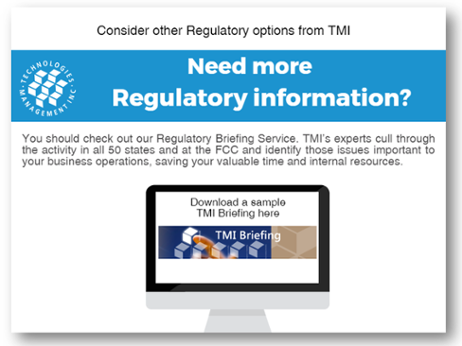 What will the FCC be tackling next?
What will the FCC be tackling next?
Chairman Pai has called it a “Energetic November” and I think that’s probably a fair reading of the FCC’s varied agenda for its November 16, 2017, Open Meeting. The agenda items range from accelerating broadband deployment to reforming the Lifeline program and from robocalling to eliminating some cable reporting requirements. There’s something for everyone, whether you are an incumbent local exchange carrier (ILEC), a competitive local exchange carrier (CLEC), a wireless provider, or a cable provider. So, let’s take a closer look at some of the issues the FCC will be addressing.
Wireline Broadband Deployment
 This is by far the most complex item on the agenda. It truly offers something for everyone - and everyone is both a potential winner and a potential loser. Indeed, it contains not only a Report and Order but also a Declaratory Ruling and Further Notice of Proposed Rulemaking (FNPRM)!
This is by far the most complex item on the agenda. It truly offers something for everyone - and everyone is both a potential winner and a potential loser. Indeed, it contains not only a Report and Order but also a Declaratory Ruling and Further Notice of Proposed Rulemaking (FNPRM)!
Starting with pole attachment reforms, the Order would establish a 180-day shot clock for resolution of complaints alleging a denial of access to poles, with the shot clock starting the day the complaint is filed. This should be a big positive for competitors. The Order would also guarantee ILECs access to poles owned or controlled by CLECs.
 Regarding the network change notification process, the Order would eliminate the current prohibition on ILECs’ disclosure of information about planned network changes prior to public notice.
Regarding the network change notification process, the Order would eliminate the current prohibition on ILECs’ disclosure of information about planned network changes prior to public notice.
Concerning copper retirement, the Order would roll-back many of the reforms adopted in 2015. The Order would also limit the notice obligation to only directly interconnecting providers and reduce the waiting period from 180 days after release of an FCC public notice to 90 days after release of the public notice.
On the other hand, the Order would streamline the discontinuance of service process for all carriers by reducing the public comment period for applications seeking to: (i) stop taking new customers for low-speed legacy voice and data services; (ii) discontinue low-speed legacy data services for which carriers already are not taking new customers; and (iii) discontinue low-speed legacy voice and data services with no customers. The FNPRM seeks comment on several other proposals aimed at further streamlining the process for all providers seeking to grandfather data services with speed less than 25 Mbps/3 Mbps or discontinue a grandfathered service.
Wireless Deployment
This more focused Order would eliminate the requirement for historic preservation review when utility poles are replaced with substantially identical poles that can support antennas or other wireless communications equipment. Replacement utility poles would be excluded from review when:
- the original pole is not itself a historic property; and
- the replacement pole will be placed in the same hole, will have an appearance consistent with the original, and will cause no new ground disturbance.
 Robocalling
Robocalling
The FCC is proposing to authorize voice service providers to:
- block calls when the subscriber to a particular telephone number requests blocking of calls appearing to be from that number (“Do-Not-Originate” or “DNO” requests);
- block calls when the Caller ID can’t be valid (e.g., numbers with area codes that don’t exist, numbers that have not been allocated to a provider, and numbers allocated to a provider but not currently in use.
I’m not sure what various providers may think of this item, but as a recipient of way too many unwanted robocalls, I welcome any help my wireline or wireless provider can offer me!
 Lifeline
Lifeline
The FCC is proposing significant reforms to its Lifeline program, reforms which have already drawn public criticism from Commissioner Clyburn. This is another item where there’s some to love and some to hate, depending on your perspective. Initially focusing on the enhanced Lifeline support available for residents of Tribal Lands, the Order proposes actions designed to target such support to residents of rural areas on Tribal lands. Only subscribers whose residential address or location is shown to fall within the boundary of newly-created enhanced Tribal Lifeline maps would be eligible to receive this enhanced support. And only facilities-based service providers would be able to receive reimbursement for providing such service.
More generally, the Order also proposes to:
- eliminate the current Lifeline benefit port freezes for voice and broadband services;
- clarify that where the National Verifier is responsible for the consumer’s initial eligibility determination or recertification, it is not required to deliver copies of those certifications to the Lifeline provider;
- clarify that broadband Internet access delivered via Wi-Fi is not eligible for reimbursement as mobile broadband under the Lifeline program rules; and
- clarify that a provider does not directly serve a customer with fixed broadband service under the Lifeline rules if that customer cannot access the services at their residential address and, therefore, Wi-Fi offerings like the “premium Wi-Fi” service described in the record also do not qualify for Lifeline support as fixed broadband service offerings.
 The item also includes a Notice of Inquiry about potential changes to program funding that includes questions about requiring a mandatory contribution from all Lifeline subscribers (presumably aimed at stopping wireless providers from offering what amounts to “free” Lifeline service) and implementing limits on the dollar amount of Lifeline benefits any one subscriber may receive, or limiting the length of time for which an individual may receive Lifeline benefits.
The item also includes a Notice of Inquiry about potential changes to program funding that includes questions about requiring a mandatory contribution from all Lifeline subscribers (presumably aimed at stopping wireless providers from offering what amounts to “free” Lifeline service) and implementing limits on the dollar amount of Lifeline benefits any one subscriber may receive, or limiting the length of time for which an individual may receive Lifeline benefits.
Watch for the upcoming and detailed TMI Briefing regarding any developments. Get a sample Briefing via the image on the right.
Cable Reporting
Here, the FCC proposes to eliminate or, in the alternative, modernize and streamline Form 325 (Annual Report of Cable Television Systems) which collects operational information from cable television systems nationwide, including their network structure, system-wide capacity, programming, and number of subscribers. I assume this is welcome news to cable providers.
All-in-all, the November meeting promises to be a lively and interesting one!





